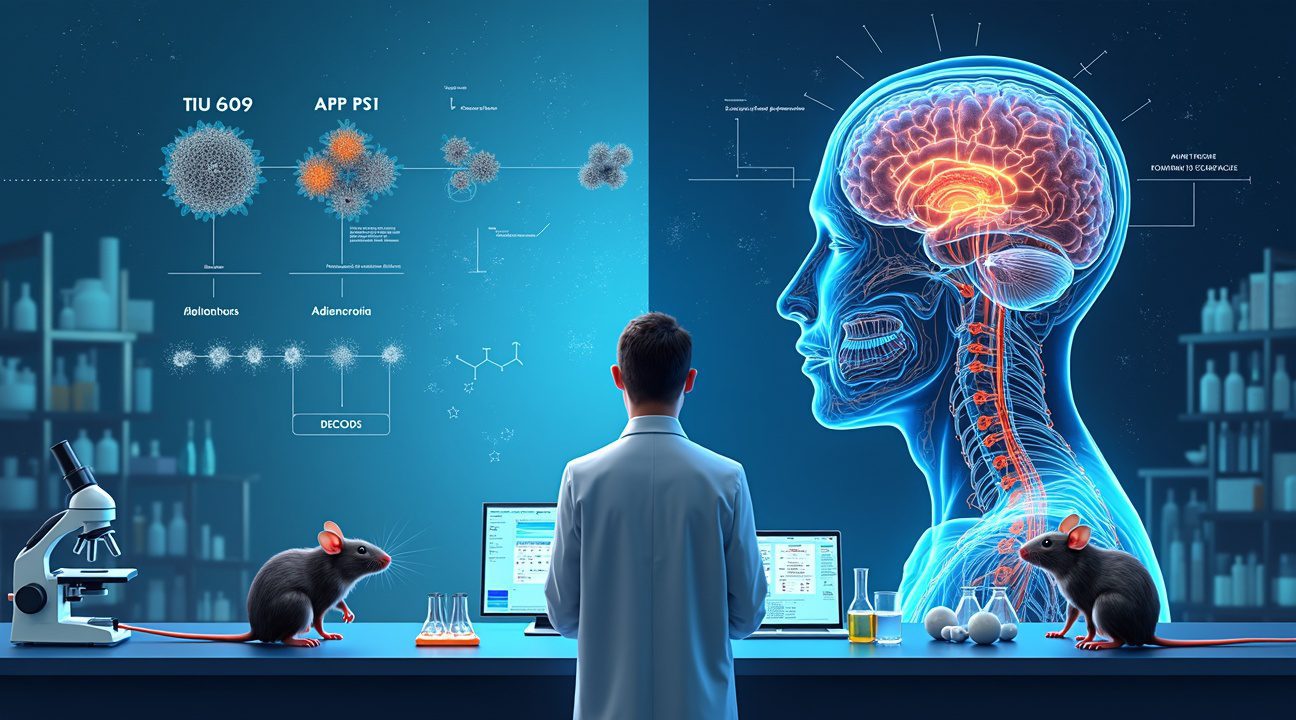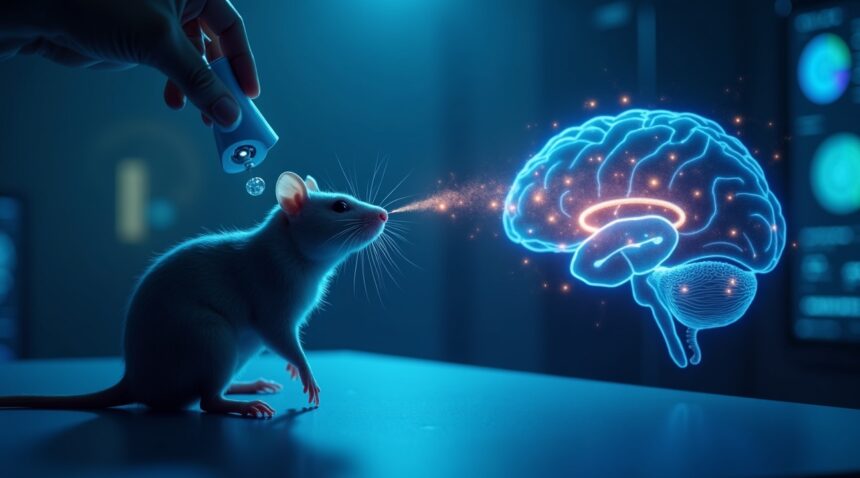Japanese scientists at the Okinawa Institute of Science and Technology achieved a remarkable breakthrough by using a nasal peptide called PHDP5 to reverse Alzheimer’s-like symptoms in mice, restoring 55% of their memory function and bringing cognitive performance nearly equal to healthy mice.
This innovative treatment works by repairing damaged brain connections through targeted intervention of dynamin-microtubule interactions, offering hope for actual restoration of cognitive abilities rather than just slowing disease progression.
Key Takeaways
- PHDP5 peptide delivered through nasal spray restored 55% of memory function in Alzheimer’s mice, compared to only 33% improvement in untreated control mice.
- The treatment bypasses the blood-brain barrier through intranasal delivery, reaching therapeutic concentrations directly in the hippocampus within minutes.
- PHDP5 blocks harmful dynamin-microtubule interactions caused by tau protein accumulation, restoring proper neuron-to-neuron communication.
- This breakthrough signals a shift from symptom management to repair of damaged brain circuits, offering potential hope to the 55 million Alzheimer’s patients worldwide.
- Human clinical trials are still years away, as translation from mouse models to humans demands extensive safety and efficacy evaluations.
To read more on this discovery, visit the Okinawa Institute of Science and Technology news page.
Mice Memory Restored by 55% with Revolutionary Nasal Peptide Treatment
I’ve witnessed countless research breakthroughs, but this discovery from Japanese scientists represents a genuine leap forward in Alzheimer’s treatment. The team at the Okinawa Institute of Science and Technology achieved something remarkable: they reversed memory loss in mice using a simple nasal spray containing a synthetic peptide called PHDP5.
PHDP5 Peptide Delivers Unprecedented Memory Recovery
The research focused on Tau609 transgenic mice, which develop tau tangles and memory loss similar to human Alzheimer’s disease. These mice typically struggle with basic learning tasks, performing poorly compared to healthy wild-type mice. However, after receiving the PHDP5 treatment through intranasal delivery, their cognitive abilities showed dramatic improvement.
The results speak volumes about this peptide’s potential. Treated mice achieved a 55% improvement in memory task performance, bringing them nearly equal to healthy wild-type mice. Control mice with Alzheimer’s-like pathology managed only a 33% improvement without treatment. This 22-percentage-point difference demonstrates the peptide’s significant impact on cognitive function.
Memory retention tests provided equally compelling evidence. The treated mice spent 33% of their time in the correct memory quadrant during testing, almost matching the 36% performance of wild-type mice. Untreated control mice could only manage 25% accuracy, highlighting the substantial cognitive deficit that PHDP5 successfully addressed.
Synapse Function Restoration Through Dynamin-Microtubule Interaction
The peptide works by targeting dynamin-microtubule interaction within brain cells, particularly in the hippocampus region crucial for memory formation. This mechanism helps restore proper synapse function, which becomes compromised in Alzheimer’s disease due to tau protein accumulation and tangle formation.
Intranasal treatment offers several advantages over traditional drug delivery methods. The peptide bypasses the blood-brain barrier, delivering therapeutic compounds directly to brain tissue through nasal passages. This approach reduces systemic side effects while ensuring higher concentrations reach the target areas where cognitive decline occurs.
The OIST research team’s work builds on our growing understanding of how memory formation processes can be disrupted and potentially restored. Their findings suggest that addressing specific protein interactions at the cellular level can reverse established cognitive deficits rather than merely slowing their progression.
Scientists have long searched for treatments that could restore lost cognitive abilities rather than just preventing further decline. This research demonstrates that damaged neural connections aren’t permanently broken but can be repaired through targeted intervention. The peptide essentially helps neurons rebuild their communication networks, allowing information to flow properly again.
The treatment’s effectiveness in mouse models provides hope for human applications, though researchers must conduct extensive safety and efficacy studies before clinical trials begin. The dramatic improvement shown in these Tau609 mice suggests the approach could benefit patients with existing Alzheimer’s symptoms, not just those in early stages of the disease.
Similar breakthrough research continues advancing our understanding of brain function and repair mechanisms. Scientists recently achieved success with adaptive technologies and discovered biological building blocks in unexpected places, showing how innovation spans multiple scientific disciplines.
The PHDP5 peptide treatment represents a shift from symptom management to actual restoration of cognitive function. Rather than slowing Alzheimer’s progression, this approach actively repairs damaged brain circuits and restores memory capabilities that patients have already lost. The 55% improvement in memory performance demonstrates the treatment’s potential to give patients back abilities they thought were gone forever.
How PHDP5 Repairs Brain Communication by Targeting Tau Protein Damage
PHDP5 operates through a precise mechanism that directly addresses one of Alzheimer’s most destructive processes. The peptide specifically inhibits the harmful interaction between dynamin and microtubules, preserving dynamin’s availability for vesicle endocytosis—a critical process that enables neurons to communicate effectively with one another.
The Dynamin-Microtubule Connection
Dynamin serves as a molecular motor essential for proper synaptic function, but tau protein accumulation disrupts its normal operation. When tau builds up in brain cells, it creates abnormal interactions between dynamin and microtubules, essentially hijacking dynamin away from its intended purpose. This disruption severely compromises vesicle endocytosis, the cellular process responsible for recycling neurotransmitter receptors and maintaining synaptic plasticity.
PHDP5 intervenes by specifically targeting this dynamin-microtubule interaction pathway. By blocking these harmful connections, the peptide restores dynamin’s ability to perform its essential functions in neuron-to-neuron communication. The restoration of this process allows synapses to regain their capacity for proper signal transmission, effectively reversing the communication breakdown that characterizes early Alzheimer’s disease.
Timing and Effectiveness of Treatment
The peptide demonstrates remarkable effectiveness when administered during early disease stages, before extensive neuronal damage occurs. Timing proves crucial because PHDP5 can reverse cognitive deficits by restoring synaptic communication, but its benefits diminish if administered after widespread neurodegeneration has already taken place.
Research teams reported robust and reproducible results across two different transgenic mouse models, with findings validated through rigorous double-blind testing protocols. The nasal delivery method proves particularly advantageous because it bypasses the blood-brain barrier, allowing direct access to brain tissue where the peptide can exert its therapeutic effects.
The peptide’s cell-penetrating properties enable it to reach affected neurons efficiently, making it a promising candidate for early intervention strategies. Scientists documented significant improvements in cognitive function and synaptic plasticity markers in treated mice, suggesting that brain communication can be restored through targeted molecular intervention.
This breakthrough offers hope for developing treatments that address the underlying mechanisms of neurodegeneration rather than merely managing symptoms. The ability to reverse tau-induced synaptic dysfunction represents a significant advancement in understanding how therapeutic peptides can combat Alzheimer’s disease at the cellular level.
The success of PHDP5 in mouse models demonstrates that targeted approaches focusing on specific protein interactions can yield meaningful therapeutic outcomes. Unlike broader interventions that attempt to address multiple pathways simultaneously, this peptide’s focused mechanism allows for precise correction of the cellular communication breakdown that drives cognitive decline.
Future research will likely explore:
- Optimal dosing schedules
- Long-term safety profiles
- Potential benefits for other neurodegenerative conditions involving tau protein dysfunction
The nasal delivery system’s non-invasive nature makes it particularly attractive for clinical translation, potentially offering patients a convenient treatment option that doesn’t require complex administration procedures.
Breakthrough Nasal Delivery System Bypasses Major Brain Barrier Challenge
Scientists have long struggled with one of medicine’s most formidable obstacles: getting therapeutic drugs into the brain. The blood-brain barrier acts as a protective fortress, preventing harmful substances from entering brain tissue while simultaneously blocking potentially life-saving treatments. This latest research demonstrates how intranasal delivery offers an elegant solution to this persistent challenge.
PHDP5 was administered directly through the nasal cavity, successfully crossing the blood-brain barrier to target the hippocampus – the brain’s primary memory center. This delivery method bypasses the protective barrier entirely, allowing peptides like PHDP5 and JAL-TA9 to reach critical brain regions efficiently. The nose-to-brain pathway represents a major advancement in neurodegenerative disease drug development, where traditional oral or injection methods often fail to deliver adequate therapeutic concentrations.
The synthetic PHDP5 peptide was specifically engineered to be cell-penetrating and optimized for nasal delivery. This careful design yielded significantly higher concentrations in the hippocampus compared to other administration routes. Scientists created this peptide with enhanced stability properties, ensuring it remains active during its journey through nasal passages into brain tissue.
Superior Brain Uptake Through Olfactory Pathways
Research comparing different delivery methods revealed remarkable advantages of intranasal administration. Studies with peptides like JAL-TA9 confirmed superior brain uptake and retention compared to intravenous or intraperitoneal methods. The speed of delivery proved equally impressive – maximal concentrations were detected in the olfactory bulb within just 5 minutes, while other brain regions showed peak levels up to 60 minutes post-delivery.
Key benefits of nasal administration include:
- Direct access to brain tissue through olfactory pathways
- Rapid onset with therapeutic levels achieved within minutes
- Minimal systemic circulation reducing potential side effects
- Higher bioavailability in target brain regions
- Reduced drug clearance by liver and kidneys
This targeted approach minimizes systemic clearance and potential side effects while delivering therapeutic concentrations directly to affected brain regions. Unlike traditional methods that distribute medication throughout the entire body, intranasal delivery concentrates the therapeutic effect exactly where it’s needed most. The research builds on previous discoveries about how certain substances can transform their properties to overcome biological barriers, much like how PHDP5 adapts to navigate brain pathways. Scientists continue exploring how this delivery system might benefit other neurological conditions, potentially opening new treatment avenues for conditions affecting brain function and essential biological processes.
https://www.youtube.com/watch?v=FzYFzE3vKQg

New Hope for 55 Million Alzheimer’s Patients Worldwide
Alzheimer’s disease currently devastates approximately 55 million people across the globe, creating an urgent need for effective treatments that can address this growing crisis. Japan faces particularly steep challenges, with 4.4 million cases documented in 2021, and projections indicating this number will surge to 6.5 million by 2060. These staggering statistics underscore why breakthrough research like the PHDP5 peptide therapy represents such a critical advancement in neurodegenerative disease therapeutics.
Current treatment options remain frustratingly limited for patients and families grappling with Alzheimer’s progression. Existing therapies, including monoclonal antibodies such as aducanumab, provide minimal benefits and target only specific aspects of the disease. I’ve observed that these conventional approaches primarily focus on amyloid plaque removal but often fail to address the comprehensive damage occurring within brain tissue. Scientists have long recognized that this narrow focus leaves many therapeutic opportunities unexplored.
Revolutionary Approach Targets Root Causes
The PHDP5 approach pioneered by OIST research teams offers an entirely different therapeutic avenue by concentrating on synaptic repair and tau protein pathology rather than exclusively targeting amyloid plaques. This strategy addresses fundamental mechanisms that drive cognitive decline, potentially offering more comprehensive protection for brain function. Research findings suggest that restoring synaptic connections could prove far more effective than previous methods that focused primarily on plaque reduction.
The peptide’s ability to reverse cognitive symptoms in laboratory mice demonstrates remarkable potential for clinical translation. Scientists administered the treatment through nasal delivery, which offers several advantages over traditional drug delivery methods. This approach bypasses the blood-brain barrier challenges that have hindered many previous therapeutic attempts, allowing direct access to affected brain regions.
Evidence from these studies indicates that PHDP5 treatment can delay or potentially reverse cognitive decline within clinically relevant timeframes. Such results represent a fundamental shift from current treatments that merely slow disease progression. Patients who might benefit from this therapy could experience actual improvement in memory and cognitive function rather than simply maintaining their current state.
The research team continues working to optimize the peptide formulation and strengthen their findings through advanced analytical methods. They’re employing AI to enhance data analysis capabilities, which allows for more precise understanding of how the treatment affects different brain regions and cellular processes. This technological integration accelerates the development timeline while improving the accuracy of therapeutic predictions.
Human clinical trials remain essential for validating these promising laboratory results. Pharmaceutical partnerships are actively being pursued to facilitate drug development and fund the extensive testing required for regulatory approval. Companies specializing in neurodegenerative therapeutics represent ideal collaborators for advancing this research from laboratory to clinic.
If human trials replicate the success observed in animal models, millions of Alzheimer’s patients could benefit from this innovative approach. The therapy’s potential to restore brain connections offers hope for patients currently facing inevitable cognitive decline. Families watching loved ones struggle with memory loss might finally have access to treatment that provides genuine improvement rather than temporary stabilization.
The global impact of successful PHDP5 therapy extends beyond individual patients to entire healthcare systems struggling with Alzheimer’s care costs. Effective treatment could reduce the burden on caregivers, decrease institutionalization rates, and allow patients to maintain independence longer. These broader benefits make the research investment worthwhile from both humanitarian and economic perspectives.
Recent discoveries in neuroscience continue revealing new possibilities for treating conditions once considered hopeless. Just as researchers have made progress understanding the cause of deja vu, breakthrough studies like the PHDP5 research demonstrate how innovative approaches can unlock therapeutic potential in complex neurological conditions.

Why Human Trials Still Need Years Despite Promising Results
Animal models like Tau609 and APP/PS1 mice provide valuable insights, but they don’t perfectly mirror human Alzheimer’s disease. I recognize that these models capture specific aspects of the condition, yet significant biological differences exist between mouse and human brain physiology. The complexity of human neural networks and the decades-long progression of Alzheimer’s in people create challenges that laboratory animals simply can’t replicate.
Limitations of Preclinical Models
Current animal models focus on isolated disease mechanisms rather than the full spectrum of human Alzheimer’s pathology. Tau609 mice primarily develop tau protein tangles, while APP/PS1 models concentrate on amyloid plaques. Human disease involves both pathologies simultaneously, along with neuroinflammation and vascular changes that aren’t fully represented in these models. Scientists must also account for genetic diversity in human populations, something standardized laboratory mice can’t address. These limitations explain why many promising treatments that work in animals fail during human trials.
- Single-pathology focus: Most models study either tau or amyloid, not both.
- Lack of neuroinflammation modeling: Inflammation in the human brain is complex and not effectively mimicked.
- Genetic variability: Human populations show diversity that isn’t captured in inbred mice strains.
The Long Road to Clinical Translation
Translational research demands rigorous testing phases that can’t be rushed.
- Phase I: Focuses on safety and dosage in small groups of healthy volunteers or patients.
- Phase II: Evaluates preliminary efficacy and short-term side effects in a slightly larger patient group.
- Phase III: Involves long-term testing on large patient populations compared against existing therapies.
Each phase typically takes 1–3 years, and that’s after extensive preclinical safety testing. Regulatory approval processes require comprehensive data showing both effectiveness and safety across diverse patient populations.
Biomarker validation presents another significant hurdle. Researchers need reliable ways to measure treatment success in humans, which often differs from animal model outcomes. The nasal peptide’s effects on brain connections must be measurable through imaging or cognitive assessments that regulatory agencies will accept.
Drug development timelines reflect these complexities. Pharmaceutical companies typically invest 10–20 years from initial laboratory discovery to market approval. This timeline accounts for unexpected setbacks, manufacturing scale-up challenges, and the thorough documentation required for regulatory submission. Financial considerations also play a role, as companies must balance research costs against potential returns.
The encouraging results in mice certainly warrant optimism, but human trials will determine whether this nasal peptide approach can safely and effectively treat Alzheimer’s patients. Scientists have learned from past disappointments that promising animal results don’t guarantee human success, making careful, methodical progression through clinical trials essential for developing truly effective treatments.

Sources:
Medical News Today – “Peptide treatment could reverse cognitive decline in Alzheimer’s disease”
EMBO Molecular Medicine – “PHDP5 peptide restores memory function in mice with tauopathy by modulating dynamin-microtubule interactions”
SciTechDaily – “Alzheimer’s Breakthrough: New Peptide Treatment Reverses Cognitive Decline”
PubMed – Article ID 37449319


